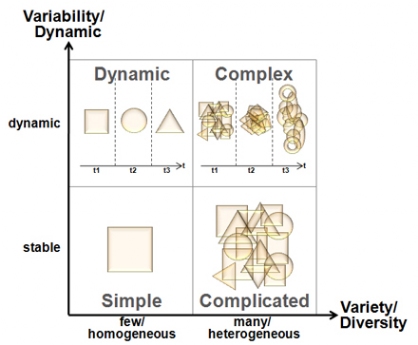System complexity
System complexity enables the classification of systems of all kind. Based on it different course of action can be derived for review, communication and control. The usage goes across all levels of meaning design, i.e. idea development, communication management and business design.
The system complexity results out of two dimensions: the variability/ dynamic and the variety/ diversity. (The model is based on a model of Ulrich/ Probst; Anleitung zum ganzheitlichen Handeln).

· Variability/ Dynamic
The variability results from the fact, whether the system changes in the defined time frame (dynamic) or not (stable). The considered time frame can be short or long term. Stable systems allow a detailed and long-term investigation, because the system is not changing. Dynamic systems require a needs-oriented and fast approach.
· Variety/ Diversity
Variety comes from the amount of elements, that define a system. Diversity comes from the heterogeneity of the elements. The amount of elements can be manageable or not. A simple system consists of few, homogeneous elements; the simplest case might be one. The system becomes complicated with heterogeneous elements; in the most complicated case a lot and always different.
A grid of four fields Based can be created with these two dimensions: simple, dynamic, complicated and complex.
· Simple
Simple systems with few elements are easy to describe and need few attention, after they work – e.g. simple commodities (e.g. knife, bottle), construction plan of a house. Pictures and textual descriptions of each element can be used for documentation.
· Dynamic
Dynamic systems with few elements are changing in the course of a certain time. The changes are happening fast or slow with a regular or irregular rhythm. The few amount of elements can be well described, but have to be held current and might be expanded over time – e.g. heating systems, beverage storage, gas tank. Besides the documentation of the elements, additional aspects have to be explained, e.g. former changes and/or mechanisms of change (e.g. the range of a thermostat).
· Complicated
Complicated systems with a lot of elements are difficult to understand, but can be well described with according time. To ensure the up-to-dateness it has to be reviewed regularily, whether something has changed – examples are: city map, train route network, engine plan. The documentation consists of many figures and texts of the elements, due to complicatedness.
· Complex
Complex systems cannot be documented completely, because the variety and diversity is so huge and always changing before the description can be finished. The keep usability a different level of description is required. That’s why for example weather systems, social systems, traffic jam planning’s have simulations with cause-effect-relations, probability values, patterns besides the general description of the elements.
